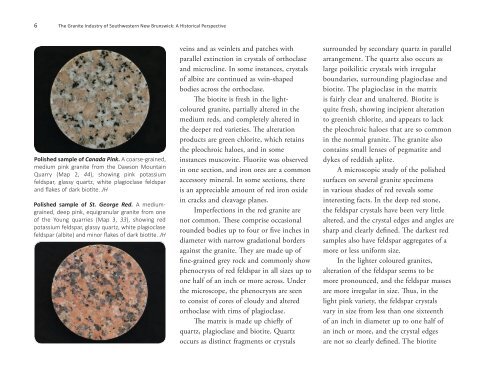The Granite Industry of Southwestern New Brunswick: A Historical ...
The Granite Industry of Southwestern New Brunswick: A Historical ...
The Granite Industry of Southwestern New Brunswick: A Historical ...
You also want an ePaper? Increase the reach of your titles
YUMPU automatically turns print PDFs into web optimized ePapers that Google loves.
6 <strong>The</strong> <strong>Granite</strong> <strong>Industry</strong> <strong>of</strong> <strong>Southwestern</strong> <strong>New</strong> <strong>Brunswick</strong>: A <strong>Historical</strong> Perspective<br />
Polished sample <strong>of</strong> Canada Pink. A coarse-grained,<br />
medium pink granite from the Dawson Mountain<br />
Quarry (Map 2, 44), showing pink potassium<br />
feldspar, glassy quartz, white plagioclase feldspar<br />
and flakes <strong>of</strong> dark biotite. JH<br />
Polished sample <strong>of</strong> St. George Red. A mediumgrained,<br />
deep pink, equigranular granite from one<br />
<strong>of</strong> the Young quarries (Map 3, 33), showing red<br />
potassium feldspar, glassy quartz, white plagioclase<br />
feldspar (albite) and minor flakes <strong>of</strong> dark biotite. JH<br />
veins and as veinlets and patches with<br />
parallel extinction in crystals <strong>of</strong> orthoclase<br />
and microcline. In some instances, crystals<br />
<strong>of</strong> albite are continued as vein-shaped<br />
bodies across the orthoclase.<br />
<strong>The</strong> biotite is fresh in the lightcoloured<br />
granite, partially altered in the<br />
medium reds, and completely altered in<br />
the deeper red varieties. <strong>The</strong> alteration<br />
products are green chlorite, which retains<br />
the pleochroic haloes, and in some<br />
instances muscovite. Fluorite was observed<br />
in one section, and iron ores are a common<br />
accessory mineral. In some sections, there<br />
is an appreciable amount <strong>of</strong> red iron oxide<br />
in cracks and cleavage planes.<br />
Imperfections in the red granite are<br />
not common. <strong>The</strong>se comprise occasional<br />
rounded bodies up to four or five inches in<br />
diameter with narrow gradational borders<br />
against the granite. <strong>The</strong>y are made up <strong>of</strong><br />
fine-grained grey rock and commonly show<br />
phenocrysts <strong>of</strong> red feldspar in all sizes up to<br />
one half <strong>of</strong> an inch or more across. Under<br />
the microscope, the phenocrysts are seen<br />
to consist <strong>of</strong> cores <strong>of</strong> cloudy and altered<br />
orthoclase with rims <strong>of</strong> plagioclase.<br />
<strong>The</strong> matrix is made up chiefly <strong>of</strong><br />
quartz, plagioclase and biotite. Quartz<br />
occurs as distinct fragments or crystals<br />
surrounded by secondary quartz in parallel<br />
arrangement. <strong>The</strong> quartz also occurs as<br />
large poikilitic crystals with irregular<br />
boundaries, surrounding plagioclase and<br />
biotite. <strong>The</strong> plagioclase in the matrix<br />
is fairly clear and unaltered. Biotite is<br />
quite fresh, showing incipient alteration<br />
to greenish chlorite, and appears to lack<br />
the pleochroic haloes that are so common<br />
in the normal granite. <strong>The</strong> granite also<br />
contains small lenses <strong>of</strong> pegmatite and<br />
dykes <strong>of</strong> reddish aplite.<br />
A microscopic study <strong>of</strong> the polished<br />
surfaces on several granite specimens<br />
in various shades <strong>of</strong> red reveals some<br />
interesting facts. In the deep red stone,<br />
the feldspar crystals have been very little<br />
altered, and the crystal edges and angles are<br />
sharp and clearly defined. <strong>The</strong> darkest red<br />
samples also have feldspar aggregates <strong>of</strong> a<br />
more or less uniform size.<br />
In the lighter coloured granites,<br />
alteration <strong>of</strong> the feldspar seems to be<br />
more pronounced, and the feldspar masses<br />
are more irregular in size. Thus, in the<br />
light pink variety, the feldspar crystals<br />
vary in size from less than one sixteenth<br />
<strong>of</strong> an inch in diameter up to one half <strong>of</strong><br />
an inch or more, and the crystal edges<br />
are not so clearly defined. <strong>The</strong> biotite
















